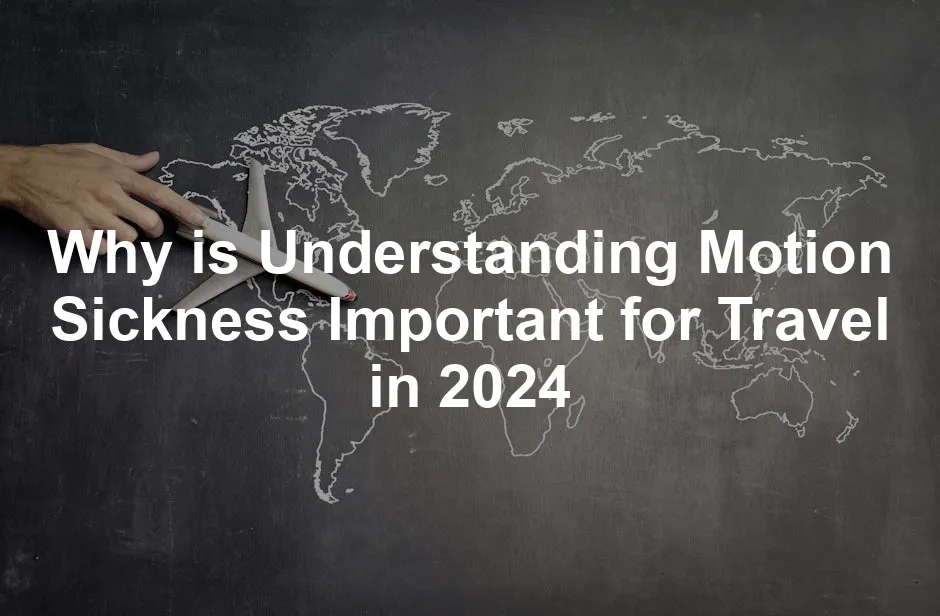
Why is Understanding Motion Sickness Important for Travel in 2024
Introduction
If you think the only thing that can ruin a perfect vacation is lost luggage, think again! Motion sickness can turn a scenic road trip into a rollercoaster of nausea faster than you can say, “Are we there yet?” This pesky condition affects countless travelers each year, transforming delightful journeys into episodes of discomfort. Understanding motion sickness is crucial as we navigate a post-pandemic world where travel is resuming and evolving in 2024.
As more people venture out, the awareness surrounding motion sickness is vital. With a variety of travel options available, including planes, trains, and self-driving cars, it’s essential to grasp the nuances of this condition. After all, no one wants to spend their vacation feeling queasy while trying to enjoy the breathtaking views outside the window.
Research indicates that nearly everyone is susceptible to motion sickness to some degree. The symptoms can vary, ranging from mild dizziness to severe nausea—definitely not what you want when embarking on an adventure. In 2024, as we embrace new travel trends and technologies, understanding motion sickness takes on greater importance.
Will you be traveling in an autonomous vehicle? Engaging in virtual reality experiences? These developments may increase the likelihood of motion sickness for many individuals. So, buckle up! It’s time to learn how to navigate this phenomenon effectively, ensuring your travels are filled with joy rather than discomfort. Understanding motion sickness isn’t just a nice-to-have; it’s your ticket to a smoother journey.
To help you prepare for your travels, consider investing in a portable water bottle. Staying hydrated can help reduce the symptoms of motion sickness and keep you feeling fresh during your journeys!
To learn more about why we experience this condition, check out this article on motion sickness in cars or on boats.

Summary of Key Points
This blog post covers essential aspects of motion sickness and its implications for travelers in 2024. Here’s a brief overview of what you’ll learn:
- Definition and Causes: Motion sickness occurs when conflicting signals from the inner ear, eyes, and body create a sensory mismatch.
- Statistics on Prevalence: Motion sickness affects many, with children aged 2-12 and women statistically more susceptible.
- Preventive Measures and Treatments: Various strategies exist to help travelers avoid or manage symptoms, including medication and behavioral techniques.
- Impact on Travel Experiences: Motion sickness can detract from the enjoyment of trips, making awareness crucial.
- Future Considerations: With the rise of autonomous vehicles and virtual reality, new challenges and solutions for motion sickness are on the horizon.
Curious about personal stories or unique solutions? We’ll delve into those, too! Get ready for insights that could change how you approach travel in 2024 and beyond.

Symptoms of Motion Sickness
Motion sickness can be a real party pooper when you’re traveling. Symptoms can vary widely, but the most common ones include nausea, dizziness, and headaches. Some people might even break into a cold sweat or feel like they’re on a rollercoaster ride—minus the fun.
Nausea is often the star of the show, making you feel like you’ve just eaten a questionable seafood platter. Dizziness follows closely, making it feel like the ground is doing a little jig beneath you. Other symptoms can include vomiting, increased salivation, and even a loss of appetite. It’s like your body is throwing a tantrum because it can’t decide if it’s moving or not!
Interestingly, symptoms can differ among age groups and genders. Children aged 2 to 12 years are particularly susceptible. They might experience more intense symptoms compared to adults. Women also seem to have a higher likelihood of feeling the effects of motion sickness. Hormonal changes during menstruation or pregnancy can amplify these symptoms. If you’re traveling with kids or women of childbearing age, be prepared for potential bouts of motion sickness.
To combat the discomfort, consider packing some Dramamine Motion Sickness Relief Tablets. They can help you fight back against those pesky symptoms and ensure your travels are as smooth as possible!

Who is Most Affected?
When it comes to motion sickness, some demographics are more vulnerable than others. Research shows that children, especially those between 2 and 12, are at a higher risk. This age group often struggles with the sensation, leading to frequent complaints of feeling sick.
Women are also more prone to motion sickness than men, which may be linked to hormonal fluctuations. A study found that nearly 70% of women reported experiencing motion sickness at some point.
Statistics reveal that about 25% to 30% of adults report experiencing motion sickness during travel. Surprisingly, even the most seasoned travelers can find themselves feeling queasy at times. It’s not just a childhood phase; it can persist into adulthood.
So, whether you’re a family planning a road trip or a solo adventurer hopping on a plane, it’s wise to be aware of who might experience motion sickness more intensely. Understanding these trends can help you prepare better for your next journey.

Prevention and Management Strategies
Non-Pharmacologic Strategies
Motion sickness can feel like a cruel joke when you’re trying to enjoy the sights. Thankfully, there are several strategies to counteract the discomfort. First up, let’s talk about positioning. Choosing your seat wisely can make all the difference. On a plane, for instance, sitting over the wing often results in less turbulence. On a boat, aim for the middle, where motion is less intense.
Now, focus on stable points. Your eyes crave a fixed reference, so look at the horizon, not your phone or that novel you’ve been dying to read. Your inner ear will thank you! Staying hydrated also plays a significant role. Dehydration can amplify your symptoms, so keep that water bottle handy.
To stay organized during your travels, consider using a travel neck pillow. It can provide comfort and support, helping you catch some quality rest while on the road.
Eating light meals is another key strategy. Heavy, greasy foods can be your nemesis; instead, snack on crackers or fruit. Avoiding alcohol is also wise, as it can intensify feelings of nausea. And remember, rest is your friend! Being well-rested helps your body handle motion better.

Medications for Motion Sickness
Sometimes, despite your best efforts, motion sickness can still strike. That’s where medications come in. Antihistamines like dimenhydrinate (Dramamine) and meclizine (Bonine) are popular options. They work by blocking signals in the brain that trigger nausea and vomiting. Just be mindful—some antihistamines can cause drowsiness, so you might feel a bit like a sleepy sloth afterward.
Scopolamine is another option, often delivered via a patch placed behind the ear. It can prevent symptoms for up to three days. But remember, this isn’t a free-for-all; always consult your healthcare provider before using any medication. They’ll help you find the right dosage and determine if it’s suitable for you, especially if you have pre-existing conditions or are pregnant.
For quick relief, consider carrying Scopolamine Transdermal Patches with you. They can provide long-lasting relief for those extended journeys!
It’s crucial to test any medication at home before your trip. This way, you can assess how your body reacts without the pressure of travel.

Alternative Remedies
For those who prefer a more natural approach, several remedies may ease motion sickness symptoms. Ginger is a tried-and-true favorite. Whether in candy, tea, or raw form, ginger has shown promise in reducing nausea. Research indicates that it’s particularly effective for some travelers.
Another option is acupressure. Wristbands that apply pressure to specific points on the wrist (like the P6 point) may help relieve symptoms. Anecdotal evidence suggests that many travelers find relief using these bands.
Consider trying Sea-Bands Acupressure Wristbands for a non-invasive way to combat nausea—these could be a lifesaver during your next trip!
In one small study, participants reported less nausea when using acupressure during motion. While not all findings are conclusive, the potential benefits are worth considering.

Always keep in mind that what works for one person may not work for another. Experimenting with different strategies can help you discover what best alleviates your symptoms. By combining these remedies with proactive prevention strategies, you can tackle motion sickness head-on and make the most of your travels.

The Future of Travel and Motion Sickness
Impact of Autonomous Vehicles
As we step into the future of travel, autonomous vehicles are set to change the game. However, this innovation comes with its own set of challenges—namely, increased instances of motion sickness. Picture this: You’re relaxing in the back seat, scrolling through your phone while the car does all the driving. Sounds great, right? But the lack of control can lead to sensory overload for many passengers.
Research suggests that the transition from driver to passenger may heighten the likelihood of experiencing motion sickness. The movements of the vehicle, combined with passengers engaging in activities like reading or using screens, can create a sensory mismatch. This mismatch is a classic recipe for nausea.
To combat this, vehicle designers are brainstorming solutions. Enhanced ride comfort and better motion prediction algorithms are among the proposed innovations. For instance, incorporating smoother acceleration and deceleration can help reduce the sudden movements that often trigger symptoms.

Moreover, providing passengers with real-time information about upcoming turns and stops may help mitigate the impacts of motion sickness. By allowing passengers to anticipate movement, we can potentially reduce the confusion that leads to discomfort.
As technology evolves, staying informed about how these advancements can affect motion sickness will be crucial for future travelers. Embracing these changes while understanding motion sickness can pave the way for more enjoyable journeys ahead.

Virtual Reality and Motion Sickness
Virtual reality (VR) is an exciting frontier in travel and gaming. However, it can also bring along a side effect that feels all too familiar: motion sickness. Just like when you’re in a car and your stomach decides to join the rollercoaster ride, VR can trigger nausea and dizziness. This phenomenon is often referred to as “cybersickness.”
Cybersickness occurs when your brain receives conflicting signals. Your eyes perceive movement within a virtual environment, but your body remains still. This sensory mismatch can lead to symptoms similar to traditional motion sickness. Research shows that about 40% of users experience some form of discomfort while using VR technology.
So, how can we mitigate these effects, especially when VR becomes a travel tool in 2024? Here are some strategies.

First, take breaks! Frequent short sessions in VR can help your body adjust. If you feel queasy, remove the headset and step away for a moment. This allows your senses to recalibrate.
Second, consider using VR systems designed with comfort in mind. Some devices allow you to adjust the field of view or movement speed, significantly reducing the likelihood of feeling sick.
Lastly, practice gradual exposure. Start with less intense experiences, allowing your body to adapt before jumping into the more immersive simulations. Pairing VR experiences with physical stability—like sitting down—can also help.

Incorporating these strategies can create a smoother, more enjoyable virtual travel experience, ensuring that your adventures remain delightful rather than dizzying.
Conclusion
Understanding motion sickness is crucial for travelers in 2024. As we embrace new travel methods and technologies, being informed about motion sickness can save us from unpleasant experiences. With autonomous vehicles and virtual reality on the rise, we must recognize the potential for increased motion sickness.
It’s essential to take proactive measures. Simple strategies like choosing the right seating, looking at stable objects, and staying hydrated can make a difference. For some, medications may also play a vital role. Finding the right balance between prevention and treatment ensures that you enjoy your journey rather than endure it.
Additionally, a travel blanket can keep you cozy during your journeys, making it easier to relax and fend off those pesky motion sickness symptoms!

Travelers should share their experiences and tips for managing motion sickness. Whether it’s a remedy that worked wonders or a seating hack that saved the day, your insights could help others navigate their travels more comfortably. So, let’s start a conversation! How do you deal with motion sickness while traveling? Share your stories below, and together we can make every adventure a pleasant one. Happy travels!
FAQs
What is the best way to prevent motion sickness while traveling?
To prevent motion sickness, choose your seat wisely. Sit near the front of cars, over the wings in planes, or midship on boats. Focus on the horizon or a stable object outside. Avoid reading and heavy meals before travel. Staying hydrated with water and light snacks is also crucial. Don’t forget to get plenty of rest before your journey!
Can motion sickness be treated with medications?
Yes, motion sickness can be treated with both over-the-counter and prescription medications. Common options include antihistamines like dimenhydrinate (Dramamine) and meclizine (Bonine). Scopolamine patches are also effective for longer trips. It’s essential to consult your healthcare provider to determine the best option for you and to discuss potential side effects.
Is motion sickness common in children?
Yes, motion sickness is quite common in children, especially those aged 2 to 12 years. They often experience more severe symptoms than adults. To manage motion sickness in kids, parents can use the same strategies: seat them in the front of the vehicle, limit reading, and consider medications if needed. Always consult a pediatrician before using any medication.
Are there any long-term solutions for chronic motion sickness?
Ongoing research explores various long-term solutions for chronic motion sickness. Techniques like gradual exposure to motion, desensitization therapy, and newer medications are being studied. Some researchers are looking into virtual reality as a potential treatment method, aiming to retrain the brain’s response to motion stimuli.
What should I do if I feel motion sickness during travel?
If you start feeling motion sickness, try to sit still and focus on the horizon. Take deep breaths and sip water or a clear, fizzy drink. Ginger ale or ginger candies can also help. If symptoms worsen, find a quiet place to rest. If it becomes unbearable, consider seeking medical assistance or using medication if you have it on hand.
Please let us know what you think about our content by leaving a comment down below!
Thank you for reading till here 🙂
All images from Pexels




